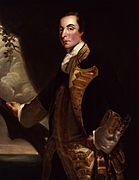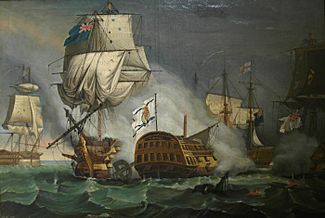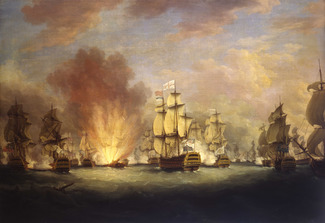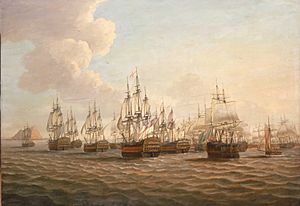Battle of Cape St. Vincent (1780) facts for kids
Quick facts for kids Battle of Cape St. Vincent |
|||||||
|---|---|---|---|---|---|---|---|
| Part of the American Revolutionary War | |||||||
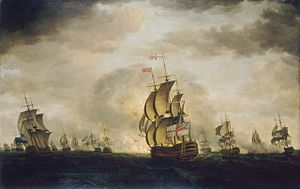 The moonlight Battle off Cape St Vincent, 16 January 1780, Francis Holman |
|||||||
|
|||||||
| Belligerents | |||||||
| Commanders and leaders | |||||||
| Strength | |||||||
| 18 ships of the line 6 frigates |
9 ships of the line 2 frigates |
||||||
| Casualties and losses | |||||||
| 134 killed and wounded | 2,500 killed, wounded or captured 4 ships of the line captured 1 ship of the line destroyed fate of 2 ships of the line disputed (see Aftermath) |
||||||
The Battle of Cape St. Vincent was a big naval battle. It happened off the coast of Portugal on January 16, 1780. This battle was part of the American Revolutionary War.
A British fleet, led by Admiral Sir George Rodney, fought against a Spanish fleet. The Spanish ships were commanded by Don Juan de Lángara. The British won this important fight.
People sometimes call it the Moonlight Battle. This is because naval battles usually stopped when it got dark. But this one kept going into the night! It was also the first big British naval victory against their European enemies in that war. The battle showed how useful copper sheathing was. This was a new way to cover the bottom of ships. It made them much faster.
Admiral Rodney was guiding supply ships to Gibraltar. Gibraltar was a British territory that the Spanish were trying to capture. Rodney had about twenty large warships with him. He met Lángara's Spanish fleet near Cape St. Vincent. When Lángara saw how many British ships there were, he tried to escape. He wanted to reach the safe port of Cádiz.
But the British ships were faster because of their copper-covered hulls. They chased the Spanish fleet. The battle lasted from the afternoon until after midnight. The British captured four Spanish ships. One of these was Lángara's main ship, the Real Fénix. Two other Spanish ships were also captured. But their Spanish crews managed to take them back later. Rodney said these ships were destroyed. In reality, one was destroyed, and the other made it back to Cadiz.
After the battle, Rodney successfully delivered supplies to Gibraltar and Minorca. Then he sailed to the West Indies. Lángara was set free and later became a high-ranking Spanish naval officer.
Contents
Why the Battle Happened
When Spain joined the American War of Independence in 1779, they had a main goal. They wanted to get back Gibraltar. Britain had taken Gibraltar from Spain in 1704. The Spanish planned to take Gibraltar by surrounding it. They wanted to stop supplies from reaching the British soldiers there.
The siege of Gibraltar officially started in June 1779. The Spanish blocked the land around the Rock of Gibraltar. But their naval blockade (blocking by sea) was not very strong. Small, fast British ships could get through. However, larger supply ships usually could not.
By late 1779, Gibraltar was running low on supplies. Its commander, General George Eliott, asked London for help. So, a large group of supply ships was put together. In late December 1779, a big fleet sailed from England. It was led by Admiral Sir George Brydges Rodney.
Rodney's main job was to command the fleet in the West Indies. But he had secret orders to first deliver supplies to Gibraltar and Minorca. On January 4, 1780, the fleet split up. Ships going to the West Indies sailed west. Rodney was left with 19 large warships. These ships were to protect the supply convoy going to Gibraltar.
On January 8, 1780, Rodney's fleet saw some ships. The faster British ships, with their copper-covered hulls, chased them. They found it was a Spanish supply convoy. It was protected by one warship and a few smaller ships. The British captured the whole convoy. The Spanish warship, Guipuzcoana, gave up after a short fight.
The British renamed Guipuzcoana to HMS Prince William. This was to honor Prince William, the King's third son. He was serving as a young officer in the fleet. Rodney sent some captured ships back to England. But Prince William joined his fleet. Some of the captured supply ships also joined him. They carried useful items for the Gibraltar soldiers.
On January 12, one of Rodney's ships, HMS Dublin, was damaged. It had to go to Lisbon for repairs. The Spanish had learned about the British supply mission. A Spanish fleet of 11 warships was sent to stop Rodney. This fleet was led by Admiral Juan de Lángara. Another Spanish fleet at Cadiz was also told to try and catch him. But the Cadiz admiral, Luis de Córdova, learned how strong Rodney's fleet was. So he went back to Cadiz instead of chasing him.
On January 16, Lángara's and Rodney's fleets saw each other. It was around 1:00 PM, south of Cape St. Vincent. The weather was hazy, with big waves and some rain.
The Moonlight Battle Begins
| Naval Commanders |
|---|
|
Admiral Rodney was sick during the battle. He stayed in his bed. His captain, Walter Young, wanted Rodney to order an attack right away. But Rodney only ordered his ships to form a line. Lángara started to get his ships ready for battle. But then he saw how many ships Rodney had. He quickly ordered his fleet to sail as fast as possible towards Cadiz.
Around 2:00 PM, Rodney was sure that the Spanish ships were not part of a bigger fleet. He then ordered a "general chase." This meant his ships should chase the Spanish at top speed. They were told to attack the Spanish ships from the rear as they caught up. They were also told to sail on the lee side (the side away from the wind). This would make it harder for the Spanish to reach a safe harbor. It also stopped Spanish ships from opening their lowest gun ports.
The British Royal Navy ships were faster. This was because of their copper-covered hulls. These hulls had less drag from sea creatures. So, the British ships quickly gained on the Spanish.
The chase lasted about two hours. The battle finally started around 4:00 PM. The Spanish ship Santo Domingo was at the back of their fleet. It was hit by several British ships. It blew up around 4:40 PM. Almost everyone on board was lost.
Another Spanish ship, Princessa, fought for an hour with the British ship HMS Bedford. Princessa finally gave up around 5:30 PM. By 6:00 PM, it was getting dark. There was a discussion on Rodney's main ship, HMS Sandwich. They talked about whether to keep fighting in the dark. They decided to continue the chase.
The chase went on into the dark, stormy night. This is why it became known as the "Moonlight Battle." It was very unusual for naval battles to continue after sunset back then. At 7:30 PM, HMS Defence found Lángara's main ship, Fenix. They fought for over an hour. Other British ships also fired at Real Fénix. Lángara was hurt in the battle.
The Real Fénix finally surrendered to HMS Bienfaisant. This ship arrived late in the fight. Its cannons shot away the Real Fénix's main mast. Taking over Real Fénix was tricky. This was because there was an outbreak of smallpox on Bienfaisant. So, Captain John MacBride did not send a crew to take over. Instead, he told Lángara about the smallpox. He let Lángara and his crew stay on their ship under a promise not to fight.
At 9:15 PM, the British ship Montagu attacked Diligente. Diligente gave up after its main mast was shot away. Around 11:00 PM, San Eugenio surrendered. All its masts were shot down by HMS Cumberland. But the rough seas made it impossible to put a British crew on board until morning.
The British ships HMS Culloden and Prince George passed this fight. They attacked San Julián. This ship was forced to surrender around 1:00 AM. The last Spanish ship to give up was Monarca. It almost got away. It shot away the top mast of HMS Alcide. But the British frigate HMS Apollo kept fighting it. Apollo managed to keep up the fight. Then Rodney's main ship, Sandwich, arrived around 2:00 AM. Sandwich fired its cannons. It did not know that Monarca had already given up.
The British captured six Spanish ships. Four Spanish warships and two frigates escaped. Some records are unclear if two of the Spanish ships were even there during the battle. Lángara's report said San Justo and San Genaro were not in his battle line. Rodney's report said San Justo escaped but was damaged. He said San Genaro escaped without damage.
-
The Moonlight Battle off Cape St. Vincent, 16 January 1780, by Richard Paton.
What Happened After the Battle
When daylight came, the British fleet and their captured ships were in danger. They were too close to the shore. The wind was blowing them towards land. One of the captured ships, San Julián, was too damaged to save. Rodney reported it was driven ashore.
Another captured ship, San Eugenio, was taken back by its Spanish crew. It managed to reach Cadiz. It was repaired and back in service within two months. A Spanish history says the British crews on these captured ships asked the Spanish prisoners for help. They needed help to escape the dangerous shore. The Spanish captains took back control of their ships. They captured the British crews and sailed to Cadiz.
The British reported their losses as 32 killed and 102 wounded. The supply convoy sailed into Gibraltar on January 19. The smaller Spanish blocking fleet retreated to Algeciras. Rodney arrived a few days later. He had stopped in Tangier first. The wounded Spanish prisoners, including Admiral Lángara, were taken off the ships there. The British soldiers in Gibraltar were very happy to see the supplies arrive. They were also excited to see Prince William Henry.
After also supplying Minorca, Rodney sailed for the West Indies in February. He sent part of his fleet to the English Channel. This fleet, heading home, stopped a French fleet going to the East Indies. They captured one warship and three supply ships. Gibraltar received supplies two more times. The siege finally ended when the war finished in 1783.
Admiral Lángara and other Spanish officers were eventually released. Lángara was promoted to lieutenant general. He continued his successful career. He became the Spanish Navy Minister during the French Revolutionary Wars. Admiral Rodney was praised for his victory. It was the first major British naval victory of the war against European enemies. He continued to do well in the war. He famously won the 1782 Battle of the Saintes. In that battle, he captured the French admiral.
Rodney's ideas about how useful copper sheathing was helped the British Navy. They decided to use this technology more widely on their ships.
Images for kids
-
Don Juan de Lángara, Spanish Admiral.
-
Admiral Sir George Rodney, British Admiral.
See also
 In Spanish: Batalla del Cabo de San Vicente (1780) para niños
In Spanish: Batalla del Cabo de San Vicente (1780) para niños



